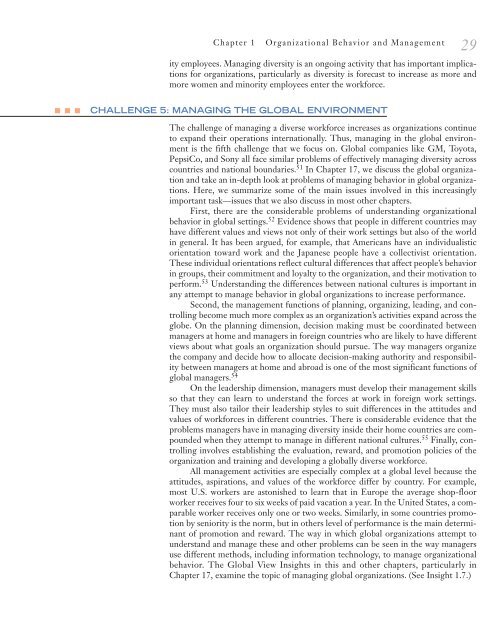chapter - Pearson
chapter - Pearson
chapter - Pearson
You also want an ePaper? Increase the reach of your titles
YUMPU automatically turns print PDFs into web optimized ePapers that Google loves.
Chapter 1<br />
Organizational Behavior and Management<br />
29<br />
ity employees. Managing diversity is an ongoing activity that has important implications<br />
for organizations, particularly as diversity is forecast to increase as more and<br />
more women and minority employees enter the workforce.<br />
■ ■ ■<br />
CHALLENGE 5: MANAGING THE GLOBAL ENVIRONMENT<br />
The challenge of managing a diverse workforce increases as organizations continue<br />
to expand their operations internationally. Thus, managing in the global environment<br />
is the fifth challenge that we focus on. Global companies like GM, Toyota,<br />
PepsiCo, and Sony all face similar problems of effectively managing diversity across<br />
countries and national boundaries. 51 In Chapter 17, we discuss the global organization<br />
and take an in-depth look at problems of managing behavior in global organizations.<br />
Here, we summarize some of the main issues involved in this increasingly<br />
important task—issues that we also discuss in most other <strong>chapter</strong>s.<br />
First, there are the considerable problems of understanding organizational<br />
behavior in global settings. 52 Evidence shows that people in different countries may<br />
have different values and views not only of their work settings but also of the world<br />
in general. It has been argued, for example, that Americans have an individualistic<br />
orientation toward work and the Japanese people have a collectivist orientation.<br />
These individual orientations reflect cultural differences that affect people’s behavior<br />
in groups, their commitment and loyalty to the organization, and their motivation to<br />
perform. 53 Understanding the differences between national cultures is important in<br />
any attempt to manage behavior in global organizations to increase performance.<br />
Second, the management functions of planning, organizing, leading, and controlling<br />
become much more complex as an organization’s activities expand across the<br />
globe. On the planning dimension, decision making must be coordinated between<br />
managers at home and managers in foreign countries who are likely to have different<br />
views about what goals an organization should pursue. The way managers organize<br />
the company and decide how to allocate decision-making authority and responsibility<br />
between managers at home and abroad is one of the most significant functions of<br />
global managers. 54<br />
On the leadership dimension, managers must develop their management skills<br />
so that they can learn to understand the forces at work in foreign work settings.<br />
They must also tailor their leadership styles to suit differences in the attitudes and<br />
values of workforces in different countries. There is considerable evidence that the<br />
problems managers have in managing diversity inside their home countries are compounded<br />
when they attempt to manage in different national cultures. 55 Finally, controlling<br />
involves establishing the evaluation, reward, and promotion policies of the<br />
organization and training and developing a globally diverse workforce.<br />
All management activities are especially complex at a global level because the<br />
attitudes, aspirations, and values of the workforce differ by country. For example,<br />
most U.S. workers are astonished to learn that in Europe the average shop-floor<br />
worker receives four to six weeks of paid vacation a year. In the United States, a comparable<br />
worker receives only one or two weeks. Similarly, in some countries promotion<br />
by seniority is the norm, but in others level of performance is the main determinant<br />
of promotion and reward. The way in which global organizations attempt to<br />
understand and manage these and other problems can be seen in the way managers<br />
use different methods, including information technology, to manage organizational<br />
behavior. The Global View Insights in this and other <strong>chapter</strong>s, particularly in<br />
Chapter 17, examine the topic of managing global organizations. (See Insight 1.7.)

















